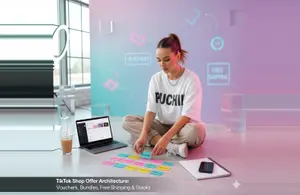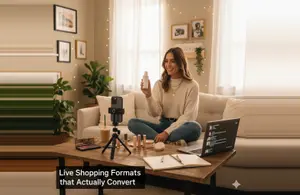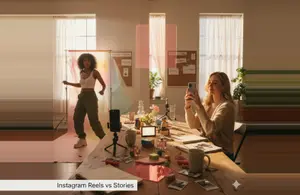What drives more value for brands: paid amplification that targets measurable conversions, or organic engagement that builds community resonance?
Marketers are grappling with this question as influencer collaborations evolve into performance-driven operations. Recent brand-influencer collab data reveals two recurring patterns:
- Creators report that boosting high-performing UGC often inflates view counts without translating to follower quality
- Engagement-first tactics—like branded hashtag challenges—consistently deliver ERs north of 15%.
These trends prompt deeper questions: How should briefs prioritize budgets between conversion and community-building? What decision frameworks can align creative assets, platform tools, and KPIs to meet both direct-response and brand affinity goals?
In this guide, we distill these questions and patterns into practical frameworks, outlining objective matrices, ROAS curve models, and implementation checklists to help agencies and in-house teams optimize every influencer campaign for the right outcome.
Defining Your Campaign Objectives
Every influencer campaign begins and ends with crystal-clear objectives that connect brand strategy, creator deliverables, and paid media execution. Without this foundation, briefs become misaligned, budgets misallocated, and performance data inconclusive.
Defining objectives in influencer collaborations requires a three-dimensional approach:
- Role in the Funnel: Identify whether the collaboration should seed awareness (top-of-funnel) or drive transactions (bottom-of-funnel). For awareness, prioritize metrics like reach, view-through rate, and engagement rate; for conversions, emphasize CPA, ROAS, and sign-up rate.
- Creative Asset Inventory: Audit existing organic assets—UGC videos, testimonials, product demos—and determine if they satisfy the brief or if new content is essential. This impacts both production timelines and budget planning.
- Channel Dynamics & Platform Tools: Leverage native features—TikTok’s Campaign Planner to forecast conversion vs. reach, Instagram Branded Content Ads for paid amplification, and YouTube BrandConnect’s Open Call for creator discovery. Understanding each platform’s strengths informs the objective alignment.
Introduce a 'Campaign Objective Blueprint' to operationalize these factors:
- Map desired outcomes to KPIs: e.g., 100,000+ reach + 5% ER for brand lift; <€5 CPA + 3x ROAS for direct response.
- Align brief sections accordingly: Campaign Goal → Creator Deliverable → Paid Amplification Format → Success Metric.
- Use a shared dashboard (e.g., Google Data Studio template) that tracks both organic and paid metrics in real time, ensuring cross-functional visibility.
Brands and agencies can streamline objective alignment by integrating TikTok’s Business Center and Meta’s Ads Manager into their briefing process. Using the Campaign Planner’s estimation tools, marketers can simulate budgets against both awareness and conversion goals, choosing the scenario that meets client ROI thresholds while maximizing creator ROI.
By anchoring every brief in this multidimensional framework, campaigns maintain strategic coherence from the initial influencer outreach through the final performance debrief. Objectives cease to be abstract directives and instead become actionable guides that inform creative decisions, budget pacing, and ongoing optimizations, ensuring every euro spent by the brand and every minute invested by the creator drives measurable value.
When to Prioritize Conversions
Conversion-driven influencer collaborations excel when campaigns require direct, measurable returns, such as product launches, subscription sign-ups, or limited-time promotions.
In these cases, conversion objectives must be embedded in every element of the influencer campaign brief, creative format, and media plan to ensure accountability and optimize spend.
@blameanthony What are Spark ads and how much should you charge for a boosted or whitelisted video? Here is everything you need to know! #contentcreator #sparkads #branddeals #ugc #socialmediaexpert #tiktokguru #socialmediatips #learnontiktok #socialmedia #influencer
1. Establish Clear Conversion Criteria in the Brief
- Define the target action (purchase, form completion, app install) and assign specific conversion KPIs (e.g., €4 CPA, 4x ROAS).
- Specify whitelisting arrangements: creators typically charge 10–25% of content production cost for Spark Ads permissions. Embed fee structures in contracts to align expectations and financial forecasts.
- Require that creators submit three script variants or caption options tied directly to the conversion offer, ensuring A/B testing capability from Day 1.
2. Integrate Algorithm-Friendly Pacing
- Allocate an initial learning budget that generates at least 50 conversions within the first 7 days, triggering TikTok’s conversion optimization and Meta’s learning phase exit.
- Structure budgets to follow a stepped increase model: maintain baseline spend until the campaign achieves target ROAS, then incrementally scale by 20% weekly while monitoring conversion curves for diminishing returns.
3. Embed Performance Thresholds and Scaling Protocols
- Use a 'ROAS Threshold Trigger': pause scaling if ROAS falls below 3x for two contiguous days; reallocate budget to top-performing creator partnerships or adjust messaging.
- Incorporate a mid-campaign creative refresh mandate: after 10,000 impressions or 25 conversions, require a new hook or testimonial clip to combat creative fatigue.
4. Drive Strategic Payoff for Agencies and Brands
- By centering conversions in both the brief and the media plan, agencies deliver transparent, revenue-focused results to clients—justifying future engagements and scaling commitments.
- Brands benefit from predictable, data-backed outcomes that tie influencer reach directly to sales, reducing reliance on ambiguous brand lift studies.
Strategic Payoff: By embedding conversion imperatives into the structural DNA of influencer briefs, spanning tracking setup, audience segmentation, optimization workflows, and attribution analysis, agencies ensure that every collaboration delivers transparent, revenue-driven outcomes that can be scaled and iterated upon with confidence.
When to Prioritize Engagement
Engagement-first influencer campaigns excel when the goal is to build brand affinity, scale organic reach, and cultivate a community around your product or service. These campaigns are ideal for new brand entrants, community-driven product categories, and aspirational lifestyle brands seeking sustained dialogue rather than immediate transactions.
1. Campaign Triggers & Briefing Criteria
Determine engagement objectives when:
- Launching evergreen content or brand awareness phases
- Running community-building initiatives (e.g., brand ambassador programs)
- Entering crowded markets where differentiation relies on social proof.
In influencer briefs, mandate two engagement-driven deliverables: a call-to-comment hook (e.g., “Share your favorite summer routine!”) and a community question overlay.
Specify platform features, such as Instagram’s Poll sticker or TikTok Duet, to incentivize participation.
2. Tactical Elements & Community Tools
- Engagement Groups Facilitation: Seed private influencer pods on Slack or Discord that meet weekly, sharing best practices and cross-promoting content. Encourage creators to post behind-the-scenes footage and respond to peers’ comments within 24 hours, boosting algorithmic visibility.
- Branded Hashtag Challenges: Design a 6-8 second core video template and distribute it to 10-15 micro-influencers with clear UGC guidelines (motion, caption hook). Use TikTok’s Hashtag Challenge Plus to embed product links, measuring challenge participation via Creator Analytics.
- Platform-Exclusive Features: Utilize Instagram’s Collab Posts to merge engagement metrics across brand and creator profiles. On YouTube BrandConnect, set up Community tab polls to drive topical conversations and surface audience sentiment.
@tiktokforbusiness Ignite MASSIVE engagement for your brand with a Branded Hashtag Challege! Learn how at the link in bio.#learnontiktok #businesscheck
3. Measurement & Optimization
Track primary KPIs: engagement rate, comment-to-view ratio, and follower growth velocity. For example, aim for an ER of ≥10% on initial content and a 15% uplift in follower growth month-over-month.
Use platform analytics to identify high-performing time slots and content formats; adjust posting schedules and creative tags accordingly. Implement monthly “engagement audits,” reviewing community sentiment, comment insights, and user-generated replies to refine the next cycle’s brief.
Strategic Payoff: By prioritizing authentic engagement, brands build long-term advocacy networks that amplify future launches at lower cost-per-engagement rates. Agencies can demonstrate uplift in brand health metrics—such as Net Promoter Score and share-of-voice—and harvest community feedback for iterative product development.
Engagement-led briefs not only ignite conversations but also create a reservoir of organic UGC that can be repurposed for subsequent conversion-focused initiatives.
KPI Decision Matrix
A KPI Decision Matrix serves as the command center for aligning influencer collaborations to brand objectives, media plans, and creative assets, mapping out clear performance targets from brief inception to campaign wrap.
By structuring a living document that evolves with real-time data, senior marketers can ensure briefs remain actionable and budgets deploy against the right metrics at each phase.
Embed the KPI Decision Matrix at the top of every influencer brief, directly following the creative deliverables section. Structure it as a two-axis tool—Objective Type (Awareness, Community, Conversion, Hybrid) on the X-axis and Performance Dimension (Engagement, Reach, Acquisition, Loyalty) on the Y-axis.
This immediately signals to creators and media buyers which metrics matter most and how assets should be tailored.
| Campaign Type | Primary KPI | Secondary KPI | Budget Split (% of Total) | Asset Focus | Forecasting Tool |
|---|---|---|---|---|---|
| Awareness | Reach (impressions, unique users) | Engagement Rate (ER) | 40% | Behind-the-Scenes UGC | TikTok Campaign Planner |
| Community | Comment-to-View Ratio | Shares & Saves | 30% | Collab Posts & Polls | Meta Audience Insights |
| Conversion | CPA (cost per acquisition) | ROAS | 50% | Long-form Notes Ads | Google Analytics Attribution |
| Hybrid | Hook Rate (3s plays per 1k imp) | Conversion Rate | 50% (even split) | Branded Hashtag Challenges | YouTube BrandConnect Tools |
Populate the matrix with campaign-specific benchmarks (e.g., a recent beauty brand saw a 15% ER using Instagram Collabs). Use forecasting modules, such as Meta’s Estimated Action Rates and TikTok’s Spend vs. Conversion simulator, to validate budget splits before launch. Link each quadrant to the brief’s creative and media plan sections so teams know which assets and audiences to prioritize.
As campaigns progress, they transition from static targets to dynamic thresholds. For example, once a conversion campaign exceeds an initial ROAS of 3x, shift 10% of the ‘Conversion’ budget into ‘Community’ to amplify high-converting content organically.
Use Google Data Studio dashboards with blended data sources (creator engagement, paid metrics, CRM) to track KPI shifts and reroute budget in real time. Document these budget pivots in the matrix’s ‘Notes’ column, creating an audit trail for post-campaign analysis.
Strategic Payoff: Implementing a KPI Decision Matrix transforms influencer briefs into living, actionable playbooks. It fosters cross-functional alignment—creative teams know which assets to produce, media buyers understand where to invest, and analysts can track performance against evolving targets.
This clarity accelerates decision-making, optimizes budget allocation, and ultimately delivers measurable ROI while building scalable frameworks for future campaigns.
Sample ROAS Curves
Understanding ROAS curves is critical for scaling influencer campaigns without overspending. A typical ROAS curve illustrates how incremental budget impacts revenue yield, highlighting the point at which additional spend yields diminishing returns.
Embedding this into briefs helps marketers decide when to scale creative partnerships or pivot to new assets.
ROAS Curve Fundamentals
Plot budget increments (x-axis) against ROAS (y-axis) using historical campaign data. Early budget increases often yield high ROAS—driven by the most responsive audience segments—until a plateau indicates market saturation.
In influencer campaigns, this plateau may occur faster if engagement groups or Spark Ads overexpose the same audience. Briefs should instruct teams to collect weekly spend vs. revenue snapshots, enabling live curve updates.
Identifying the ‘Sweet Spot’
The sweet spot is where marginal ROAS remains above the campaign’s target threshold (e.g., ≥3x). To find this, overlay actual cost and revenue data from creator-boosted content in a simple spreadsheet or BI tool like Looker.
If a product launch campaign achieved a 4x ROAS at a €5k spend but drops to 2.8x at €7k, budgets should be capped around €5–6k, and overflow directed toward engagement-driven content or new influencer cohorts.
Actionable Curve-Driven Decisions
- Scale Up: Increase spend by 20% increments while ROAS remains above the threshold.
- Cap or Reallocate: When ROAS falls below target for two consecutive reporting periods, cap budgets and redirect to underperforming channels or fresh influencers.
- Creative Iteration: Use the inflection point as a signal to refresh creative—swap a hook or introduce a new testimonial from community feedback.
Document these rules in the campaign’s “Optimization Protocol” section of the brief to ensure consistency across teams.
Strategic Payoff: By equipping influencer teams with ROAS curve insights and clear decision rules, brands can maximize return on ad spend, avoid budget waste, and seamlessly transition between conversion and engagement phases, ensuring sustainable growth and efficient resource allocation.
Conversion vs Engagement Implementation Checklist
Embed this Implementation Checklist into the final section of every influencer brief to ensure no critical step is overlooked—from initial discovery to post-campaign evaluation.
- Audience Research & Discovery: Validate competitor ad saturation via Meta Ads Library and TikTok Discover.
- Brief Finalization: Include objectives (from Objective Alignment Matrix), ROAS targets, KPI Decision Matrix, and creative specs.
- Creator Selection & Contracting: Confirm whitelisting fees, deliverable timelines, and tracking requirements in contracts.
- Creative Production & Approval: Ensure UGC scripts align with conversion or engagement goals; secure platform-specific assets (poll stickers, hashtags).
- Media Setup & Forecasting: Configure TikTok Campaign Planner and Meta’s Estimated Action Rates; set initial budgets aligned to ROAS curves.
- Launch & Day-1 Monitoring: Track 24-hour metrics against learning-phase thresholds; approve mid-campaign creative refreshes.
- Ongoing Optimization: Conduct weekly ROAS curve reviews; adjust budgets per optimization protocol; update KPI Decision Matrix.
- Post-Campaign Analysis: Blend CRM, paid metrics, and creator engagement data in Google Data Studio; document insights for next series of influencer briefs.
Strategic Payoff: This checklist transforms briefs from static documents into dynamic roadmaps that guide cross-functional teams through every campaign stage—driving consistency, accountability, and continuous improvement across influencer marketing operations.
Turning Plans into Performance
Bringing together influencer briefs, objective matrices, ROAS curve models, and implementation checklists equips marketers to execute campaigns with precision and agility. By aligning every phase—from audience discovery to post-campaign analysis—with data-driven protocols, brands can optimize both creative collaborations and media investments.
This integrated approach not only maximizes ROI but also fuels continuous learning, allowing teams to iterate on high-performing tactics and phase out underperforming elements. As the influencer landscape evolves, these frameworks become the backbone of scalable operations, enabling brands and agencies to pivot quickly, capitalize on emerging features (like Instagram Collab Posts or TikTok Dynamic Showcase), and maintain a competitive edge.
Commit to this structured methodology, and watch your influencer campaigns transform from theoretical plans into performance-driven engines that deliver measurable business growth.
Frequently Asked Questions
How can I adapt a single influencer brief for multiple regions?
To streamline cross-market launches, outline core creative requirements—key messaging, legal disclosures, and deliverables—and then layer on region-specific details, such as language nuances, local cultural references, and platform preferences. For a structured approach to localization, see the guide on localizing a single influencer brief for multiple regions.
What does an always-on influencer program framework look like?
Always-on programs maintain continuous engagement by rotating a core pool of creators against evergreen product pillars. You’ll need a rolling content calendar, monthly performance reviews, and pre-approved creative templates. For a comprehensive brief structure, refer to the always-on influencer programs brief framework.
Should I work with macro- or micro-influencers for performance campaigns?
Macro-influencers offer scale and broad reach, while micro-influencers often deliver higher engagement and niche credibility. For conversion-driven objectives, consider blending both: use macro for awareness and micro for community activation. Learn more in the briefing macro vs. micro influencers guide.
How do I balance brand guidelines with creator freedom?
Define non-negotiable brand assets (logos, mandated phrases, disclosure rules) within your brief, then outline creative zones where influencers can infuse their authentic voice. For best practices on this equilibrium, explore the article on influencer brief freedom vs. brand guidelines balance.
What should an influencer brief include for a multi-platform launch?
Specify platform-specific specs—video length, aspect ratios, caption style—and staggered posting schedules. Include primary KPIs for each channel, from TikTok conversions to Instagram engagement. A detailed example can be found in the multi-platform launch brief resource.
How do I create an influencer brief for a DTC product drop?
Anchor your brief in the consumer purchase journey: highlight unboxing moments, UGC script hooks, and clear CTAs for the product page. For a step-by-step template, review the DTC product launch influencer brief creation guide.
Can AI tools help draft influencer briefs?
Yes—AI can generate initial creative outlines, suggest hook variations, and ensure compliance language is included. Integrate AI drafts with human review for brand cohesion. Check out the tutorial on AI-powered brief drafting with GPT and Notion for implementation tips.
What role do mood boards play in influencer briefs?
Mood boards visually align creators on tone, color palettes, and reference styles. Embed sample imagery and brand visuals to guide aesthetic direction. For techniques on building effective mood boards, see creator mood-board techniques.
What legal requirements should I include in my brief for FTC compliance?
Clearly specify disclosure formats (e.g., “#ad,” “Paid partnership”), usage rights, and indemnification clauses. Reference state-of-play regulations and include model disclosure language. For a detailed checklist, consult the legal requirements for influencer briefs: usage rights & FTC lines.



